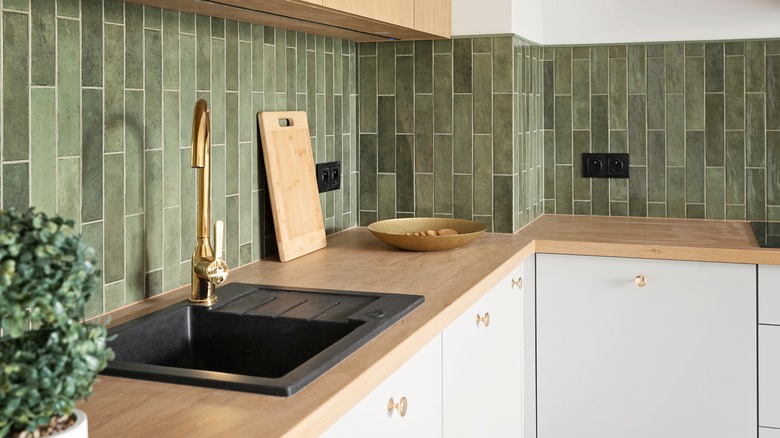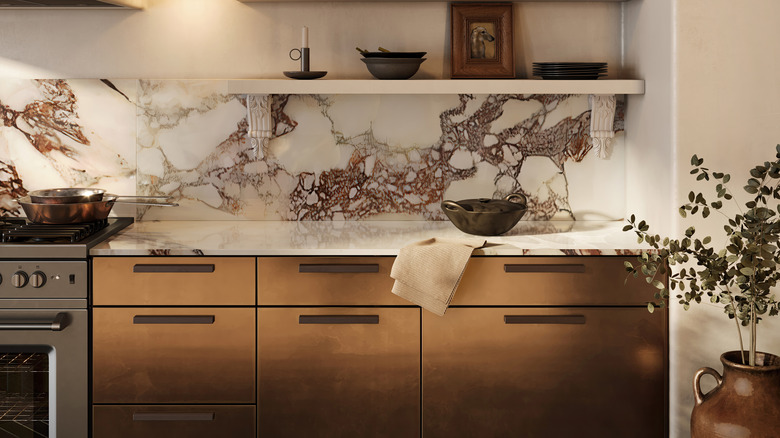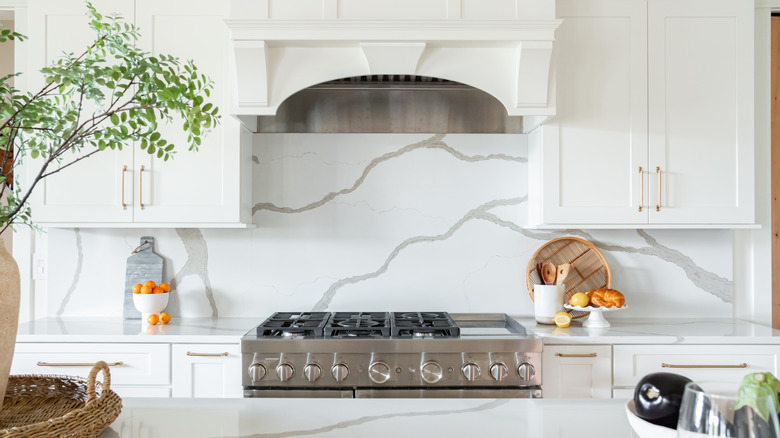Don't Make This Backsplash Mistake – Unless You Want Your Kitchen To Look Outdated
A tastefully chosen backsplash can tie together the overall vibe of your kitchen. You could pick ceramic tiles to add a sleek, natural look, or if you're going for a country or farmhouse vibe, opt for an out-of-the-box rustic backsplash. While the right choice can certainly elevate your kitchen, the wrong one can have the opposite effect and make the space look outdated. To learn more, Food Republic consulted Anna Tatsioni, lead interior designer at Decorilla.
When asked which type of backsplash to avoid, Tatsioni advised: "Busy, small mosaic tiles with multiple colors and patterns, especially the rainbow glass chip mosaics." While they had their moment in the early 2000s, contemporary kitchen design trends lean toward minimalism, featuring clean lines, neutral colors, and less clutter (which is why traditional dish racks have gone out of style). Rainbow glass chip mosaics, with their many tiles and grout lines, contrast with this sleek, minimalist look and instead make the kitchen feel visually cluttered.
While some backsplash options fall out of style, others become dated simply because of their popularity. According to Tatsioni, subway tiles in a running bond pattern have "become the equivalent of builder-grade choices." Emerging in the 1900s, they've enjoyed enduring popularity, but "when a design becomes the 'safe' option that everyone picks, it starts to age poorly," Tatsioni explained. Just like subway tiles, other popular go-to options, such as Tuscan-style stone backsplashes, have fallen out of favor after years of overuse, as no one wants their kitchen to look generic.
Alternatives to outdated backsplashes
Trends come and go. Some enjoy a fleeting but powerful moment in the spotlight, while others return in cycles. According to Anna Tatsioni, the two major factors that cause once-popular backsplashes to fall out of favor are "market over-saturation" and "difficulty of maintenance."
Take rainbow mosaic tiles, and to a lesser extent subway tiles. Both can quickly become difficult to keep clean due to grout lines — the small gaps left between tiles. The more tiles you have, the more grout lines there are. The issue is that these lines are great at collecting grease and debris from cooking, and the more grout lines you have, the more dirt build-up you'll deal with. Repetitive, time-consuming cleaning is a surefire way to ruin the charm of any backsplash. If you're set on tile, consider investing in a grout sealer to protect against stain absorption and mold growth.
For alternatives to small tiles, consider "large-format natural stone or engineered quartz slabs that reduce grout lines," Tatsioni recommended. Marble also remains a timeless choice, though its porous nature makes it prone to staining without diligent care and upkeep. For a similarly clean-lined, minimalist look, you could also consider non-natural materials like acrylic or porcelain, which add contemporary charm to a kitchen.
How to modernize an outdated backsplash
Remodeling a kitchen can be a time-consuming and costly process, but there are several cheap and easy hacks to refresh a tired backsplash. "Re-grouting existing tile in a more contemporary color, like white or light gray, can make the backsplash feel much more modern," explains Anna Tatsioni. You could also match the grout color to your backsplash to give the impression of seamless, clean lines while simultaneously removing stains from prolonged wear. If you're renting and don't want to lose your deposit, or simply aren't ready to make permanent changes, a creative way to modernize your backsplash is by covering it with a laminate sheet, which can mimic materials like stone, metal, or wood without the cost of a full remodel.
For a bolder change, Tatsioni recommends "[painting] over existing tile with specialized tile paint." This easy DIY trick can give your kitchen a fresh look. You could opt for classic neutral tones for a minimalist style, or choose cozy kitchen colors that just work, like oxblood or a deep shade of green. Just be sure to "clean, sand, and prime the tiles and then use a durable paint," Tatsioni advised. For a professional-standard finish, we recommend using an epoxy-based paint, as it's waterproof, sealing, and scratch-resistant, helping your tiles look great for longer.



